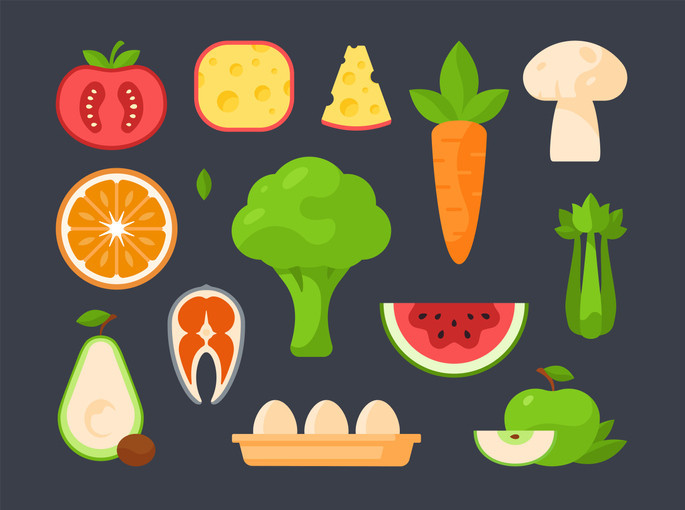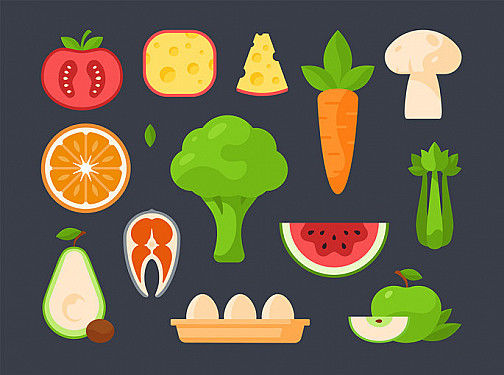Hitting start (or reset) on eating healthy.

Three months into the year is a good time to recalculate if you’ve been slacking on your resolution to eat healthy. And if you’ll be leaving home base or school soon and foraging for yourself (plus or minus roommates), it’s a great time to learn about healthy, low-cost choices for your grocery list.
The basics: A weekly shop
A healthy diet is rich in vegetables, fruits, legumes (beans or lentils), whole grains, nuts, seeds, lean proteins, and low-fat dairy products. Trying to fill your cart with all of those goodies can feel overwhelming. But just think in terms of twos.
“Get two fruits and two vegetables of different colors, and two types of lean protein — such as fresh, frozen, or canned fish, chicken or lean ground turkey, or plant-based options,” suggests Nancy Oliveira, a registered dietitian and manager of the Nutrition and Wellness Service at Harvard-affiliated Brigham and Women’s Hospital.
Oliveira also recommends getting two foods in each of these categories on your weekly shopping trip:
- plant proteins, such as canned or dried beans, tofu, tempeh, veggie burgers, or unsalted nuts or seeds
- whole grains, such as whole-grain bread, whole-grain pasta, brown or black rice, quinoa, or farro
- dairy or nondairy milk items, such as nonfat Greek yogurt or cheese.
Go ahead and add one or two healthy treats or snacks, such hummus or dried apricots.
Do you need to choose organic foods?
Organic produce is grown without synthetic fertilizers and pesticides, which are linked to many health problems. While US scientists debate whether foods grown with organic fertilizers (such as animal waste) are safer for your health, other countries, including European Union nations, have banned or phased out synthetic pesticides still used in the United States.
That doesn’t mean that everything you buy must be organic. But try to stay away from conventionally grown produce with thin skins, such as strawberries, spinach, kale, peaches, and grapes. They tend to absorb more chemicals compared to produce with thick skins, such as avocados or pineapples.
The Environmental Working Group creates an annual list to help shoppers avoid high-pesticide produce, and another one that highlights the least contaminated produce.
Buying cost-conscious fresh food and staples
Healthy food, especially organic produce, has a reputation for being expensive. But it doesn’t have to be. Just do a little comparison shopping, and follow Oliveira’s tips to save money on a grocery run:
- Shop in a smaller store with fewer choices.
- Never enter a store hungry, since you might buy more than you normally would.
- Carry a shopping list and stick to it.
- Go directly to the aisles you need. Avoid browsing elsewhere, which may lead to extra purchases.
- Be flexible, have several options within your food categories, and go with sale items.
- Always check the day-old produce cart that offers perfectly edible fresh produce at 50% to 75% off regular prices.
- Buy unseasoned canned or frozen whole foods such as vegetables, chicken, or fish (salmon, sardines, tuna), which are often cheaper than fresh versions.
- Wait for sales of healthy nonperishable staples like quinoa, brown rice, whole-grain pasta, and high-fiber cereals.
- Use coupons and coupon apps.
Easy healthy snacks to reach for
Move on from easy grab-n-go snacks, which are typically processed foods. They often contain unhealthy ingredients and promote overeating. Instead, Oliveira suggests keeping healthy snacks on hand, such as:
- unsalted mixed nuts
- string cheese
- grapes and berries (rinse before eating)
- clementines, bananas, or other fruits that don’t need washing
- a rice cake with nut butter or hummus
- fat-free Greek yogurt
- a peeled hard-boiled egg.
“To save money, buy certain foods in larger amounts when possible, such as an 8-ounce bar of cheese that you slice into small cubes and store in a sealed container in the fridge,” Oliveira says.
Crowdsource shopping tips and savings
Don’t be shy about asking for shopping tips from friends and family members who’ve already developed shortcuts, and grocery store staffers who can offer insider advice.
You can also turn to apps for help. Oliveira recommends two faves:
- Mealime is a meal-planning app with simple, healthy plant-based recipes that automatically create grocery lists for the ingredients.
- List Ease creates lists for grocery runs. You can search for items to add or scan barcodes to add to lists.
“And if you prefer not to use apps, just jot down notes after a quick pantry or fridge inventory, or text yourself every time you remember something you need,” Oliveira advises. “With a little practice, you’ll quickly work out the best system for you.”
